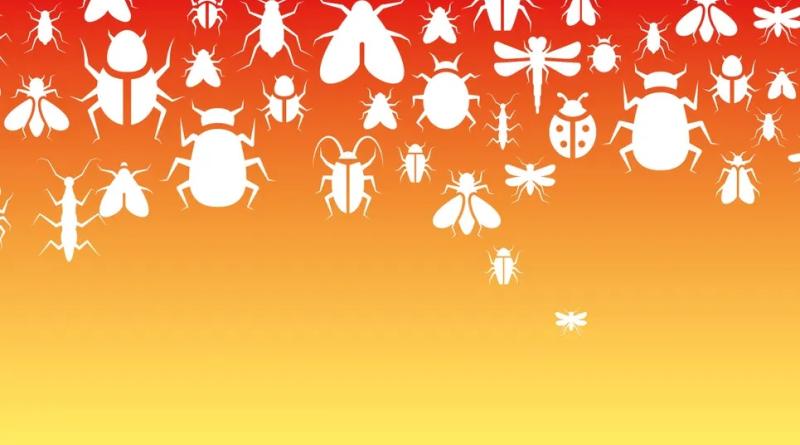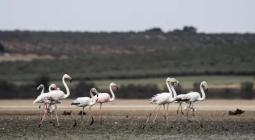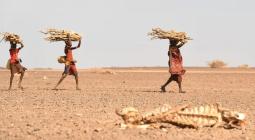Why the climate crisis is making our insects run for the hills

In the Alps and Apennines of southern Europe, nearly all the longhorn beetles are moving uphill, and way up at the peaks, the isolation of a brown butterfly with orange-tipped wings is pushing it towards extinction. This is a snapshot of a global trend. With temperatures rising and pressure on biodiversity growing, insects vital to our ecosystems are not only moving north and south, but up.
Research shows many animals are making similar moves, but insects’ high levels of mobility and short generation times allow them to respond quickly to change, meaning the uphill momentum can be rapid. Bumblebees in the Pyrenees have moved upwards on average by more than a metre a year, with some species making significantly greater journeys. Moths on Borneo’s Mount Kinabalu have followed suit.
All of this makes them a useful indicator of the speed of global heating and ecological impacts at higher altitudes – often biodiversity hotspots and havens for endemic species. To try to grasp the implications, scientists are filling their backpacks and lacing up their walking boots.
“If you want to track climate change on a mountain, you go a few metres. To do that with latitude, but on a flat basis, you have to move many kilometres,” says Prof Jane Hill from York University, who has spent years studying insects at elevation in the UK and the tropics.While the broader altitude shift is disquieting in itself, studies have also shown that reproduction and development can be hit as insects move upwards. Other possible effects are simply unknown. What is undoubtedly true is that they are not uniformly distributed, and in general, the greatest existential threat does not face those making initial forays up from the lowlands.
For species long adapted to the cooler air of higher slopes, there are fixed limits to how far they can move to find conditions conducive to survival. And yet well over half of the mountain-dwelling insects that have been studied are shifting upwards.
An upland insect close to Hill’s heart is the mountain ringlet (Erebia epiphron), a priority species in the UK biodiversity action plan. After colonising the UK following the last ice age, this dark brown butterfly with orange “eyespots” on its wings has retreated northwards and upwards to the point it now only exists at high altitudes in Scotland and the Lake District. This isolation has made the populations genetically distinct.
“It’s not a butterfly you work on if you don’t like climbing a lot of mountains,” says Hill. “But the outcome is fabulous because you’re up on the tops of these hills with beautiful clear views, because of course the butterflies only fly when the weather’s pretty good.”Without a reversal of prevailing trends or some creative intervention, such scenes are likely to become ever rarer. “The work we’ve done comes from the perspective of conserving their unique genetic diversity. Projections for climate change suggest that at the end of the next few decades, populations will disappear and we’ll potentially lose that,” she says.The mountain ringlet is not the only threatened Erebia butterfly. The likes of the Scotch argus (Erebia aethiops), also in Britain, and the dewy ringlet (Erebia pandrose) in Italy and elsewhere are also feeling the thermal and genetic squeeze. Local extinctions of these specialists have long been occurring, with global heating a significant cause. Whether this leads to a more general disappearance rests on what happens now.
In ecology, finding the “smoking gun” to neatly explain any phenomenon is generally elusive, and so it is here. Uphill movements are associated with factors beyond climate; the package of “stressors” synonymous with the so-called “insect apocalypse”. For Dr David Roy of the Centre for Ecology and Hydrology, the UK illustrates this well.
“If you think about upland species in England, they would typically be hanging on in habitats like heathland or wetland. These habitats are being built on for houses, or they’re being farmed, or they’re being made more intensive. So a lot of those sorts of species are being lost anyway, regardless of climate. But I think the evidence is that climate is adding to that pressure.”
Loss of ice and snow is synonymous with global heating, and its impact can be felt by upland insects that both develop on land and in water.There have been some dire habitat loss predictions for aquatic insects at elevation because of glaciers melting, which affects the temperature and flow of rivers and streams. With these species tending to spend the vast majority of their lives in water as juveniles, it’s hardly a surprise that 51% of high-altitude freshwater species are now classed as “highly vulnerable”.
For terrestrial mountain species, snow cover can act as a buffer against extremes. If it melts, there’s a chance that things will get much more difficult for those whose development relies on snow as an insulating “blanket” to protect them at their most fragile.
“One thing that people don’t think about as much is context: how the environment or the climate has different effects at the egg stage or the larval stages of insects,” says Prof Christy McCain, who runs Colorado University’s Mountain Lab. “We tend to always measure the adults and in summer, but that might not be the most critical time for effects of climate change, and particularly on mountains where it gets incredibly cold and dry.”
McCain believes that the way data has been collected historically is hampering their understanding, with a glut of museum specimens from low elevations, and far fewer from higher up. And while numerous studies have looked at butterflies and moths, many other groups have been neglected.
“There’s definitely a bias towards certain charismatic species. The rest of the insects, they’re just so diverse and we know so little about them,” she says.
To illustrate her point, she refers to research on carrion beetles by a student at her lab. It has shown that climate tolerance may well be an inherited characteristic in this vital group of insects, which have a major hand in decomposition and live in microhabitats that could provide some protection against the extremes. The simple fact that insects such as these have been around since the Cretaceous, living through incredible climate changes, may also favour adaptation now.
There is no such thing as a “standard insect” or response to environmental change. For some groups, it might be a case of the bigger and more mobile they are, the better their chances. There is also no generic upland habitat – and this too could prove a saving grace.
Microclimates can have a disproportionate effect at higher altitudes, with landscape features resulting in cooler and warmer patches. In some locations, climatic effects may be somewhat cushioned, allowing the most exposed species to hang on.
“In areas such as the Pyrenees, there’s quite widespread abandonment of traditional farming in montane habitats, essentially because it’s hard work. Young people are moving out into the cities, and the older generation who used to farm these places are either not here any longer or have given up,” says Roy.
“Some of those habitats are actually becoming more wooded, and this may be having the effect of cooling those environments at the same time as the climate is warming, and that might buffer against the loss of some of these species.”
Because of their enormous biomass contribution to ecosystems, changes in range and behaviour in social insects such as ants, termites and bees are an area ripe for study, says Dr Tom Rhys Bishop from Cardiff University.
His work is serving to underline the nuance at the heart of discussions around climate, habitat loss and biodiversity. In the tropics, ground-nesting ant species seem to be less at risk from rising temperatures than those that nest in tree canopies or leaf litter, quite simply because in response to the change, they can simply dig their nests deeper. Ants have shown an ability to adapt to both warm and cold conditions.
The huge impact of ant colonies on ecosystems could neatly serve to shed light on another important consideration: just what impact new arrivals at higher elevations have on those already there.
As things stand, the picture is not clearcut. In the Appalachian mountains, Aphaenogaster rudis, a traditionally low-elevation ant species, is displacing the closely related but cold-adapted species Aphaenogaster picea as it shifts upwards. In South Africa, a focus area for Bishop, similar phenomena have yet to be seen. There remain vast unknowns about such interactions, as well as much more fundamental matters.
“With climate change, things are going to get on average hotter, but also drier. That’s a major stress. But we have very little information on how lots of organisms respond to desiccation and aridity. So I’d say more information on physiological tolerances and performances is key,” says Bishop.
For social insects such as ants, bees and termites, a full understanding of the state of play across any range shift is all about the numbers.
“It’s hard to find out, for example, how many new ant queens initiated colonies. That’s quite a different, practical problem to saying how many new elephant calves were born this year in Kruger National Park, where we can see all the elephants, tag them and follow them,” he says. “Getting a handle on these population level questions is really important for understanding climate change responses, yet we are almost completely blind within ants and all other social insects as to what those patterns might be.”
Tracking ants isn’t the only logistical problem faced by those collecting the data to fill considerable knowledge gaps. The mere fact that mountains can be remote and difficult to access is a fundamental barrier, albeit one that could be overcome with a mix of “citizen science” data from those visiting mountainous regions, and automated approaches.
“We’ve sort of gone from saying, ‘Insects have shown us some really important things about how humans are altering the landscapes’, to now thinking, ‘Right, now that they are shifting and showing these changes, and that climate change is being detrimental for many species, how can we go about thinking about how to conserve them?’” says Hill.
One of the more radical proposals is to assist genetically isolated species at the limits of their range in finding suitable homes. This might mean introducing species to unoccupied areas of suitable climate to preserve their DNA, or else moving them to areas with existing populations, which could improve genetic diversity as well as their capacity to adapt to further change.
While the underlying logic of such a plan seems sound, the idea of humans moving insects from one place to another tends to raise concerns that such intervention will have unintended effects on ecosystems. Hill is undeterred.
“I think we could bring together those with knowledge of how you can successfully do it, then draw up good guidelines,” she says.
Assuming the risks are judged to be low, it would then be a question of what appetite conservation organisations have for investing in the idea. It’s relatively easy to garner support for projects protecting the habitats of easily recognisable insects that provide clear benefits such as pollination in the lowlands. For that biodiversity which is “out of sight, out of mind” for many, a stronger case may have to be made.
cover photo:Why the climate crisis is making our insects run for the hills






